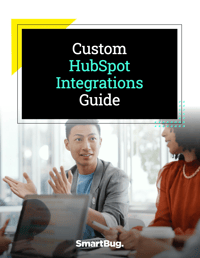
Connecting systems in the digital world is a top priority for businesses. In HubSpot, many existing integrations support what users crave: efficiency, greater functionality, and the ability to share data. However, it doesn’t cover the full breadth of applications, especially those considered niche. In these scenarios, a custom integration is the solution.
When is a custom integration the right solution? It starts with understanding a core business need. From there, the answer depends on whether relevant integrations already exist. From there, the answer depends on whether relevant integrations already exist—if they don’t, it’s almost certainly time to embark on the custom integration journey. Even if an integration is in place, it’s important to evaluate it; if a feature you need is missing or you have a particularly high-level use case, something custom might still be necessary.
Below, we discuss everything you need to know about using custom integrations to improve your tech stack.
What Is a Custom Integration?
Any connection developers have to write or build without the help of the HubSpot marketplace is a custom integration. HubSpot’s integration capabilities continue to expand through the Operations Hub, but they don’t represent every platform a business could want to link to HubSpot.
According to a ZDNET connectivity benchmark report, companies now use an average of 991 applications, yet only 28 percent are integrated. This lack of integration may be complicating digital transformation goals and operations.
Business Process Mapping for Custom Integrations
Customization work begins with understanding business needs. Questions to ask include:
- What do you need systems to do?
- How do people work?
The answers to these questions will start the conversation about how applications will work together in the future. You’ll explain the databases or systems and how they need to interact with HubSpot hubs. The discovery process involves users’ actions and tasks and fills in insights around each team’s processes, so there’s alignment from the start. You'll also identify whether a process is owned by a system, a human, or both.
At the root of this discussion is: What will make your life easier in your day-to-day operations? You don’t need to worry about all the technical stuff under the hood—that’s for your partner to worry about.
Here are some examples of issues that might necessitate a custom integration.
Data is siloed, limiting its value.
Without the ability to connect applications, data lives in vacuums. Data silos are a problem for any organization, and 81 percent of survey respondents from the benchmark report said silos were hindering digital transformation. Siloed data creates manual data extraction and inputting issues. A customized integration can eliminate these problems.
Getting data out of silos often involves synchronization between HubSpot and other business systems such as enterprise resource planning (ERP) software, custom databases, or e-commerce platforms. Breaking down silos enables systems across the enterprise to stay up to date.
Workflows have gaps.
HubSpot workflows automate processes. When designed appropriately, they ensure nothing falls through the cracks. For everything to work in harmony, you may need to integrate several systems with HubSpot.
An example is integrating HubSpot with an ERP system to connect the complete sales process. Many manufacturing companies’ ERP systems have quote systems that help them price products—but there are other systems that also need to be part of the conversation for fulfillment. There will be gaps if existing integrations aren’t available, making a custom one necessary.
Legacy systems are an obstacle.
Legacy systems can be challenging, but there are ways to rework them with a new path. Old technology often doesn’t integrate with more modern applications. If you can’t sunset a legacy system completely, a custom connector could get these systems talking to each other with less friction.
Our team completed a project with an AS400 mainframe with no API for connection. The solution was to communicate through the system using the database to create a bridge from the old platform to the new one.
You’re missing business intelligence insights.
Every business wants to be more data-driven, leading to the rise of data warehouses that push information to other systems and ingest it. This can be a complex framework with holes resulting from ineffective links. A customized integration can resolve these challenges.
You’d like to keep only necessary users in complex systems.
Some platforms can seem like a maze to those who aren’t experts—but those people need information housed in those platforms.
For example, the radio industry uses traffic systems to manage inventory availability. The primary users are traffic managers. But sellers also have to access the system to see open spots for proposals, which they’ll need to record in Sales Hub and other modules.
It's a frustrating experience for sellers and slows down their workflows. Sales Hub offers an ideal solution to the swivel-chair dilemma. Salespeople get the information they need without usability issues with an integration customization.
Examples of Custom Integrations
We’ve worked on many custom integration projects for HubSpot users. Here are a few examples.
Niche or home-grown CRMs need to push and pull data from Marketing Hub.
HubSpot provides an easy CRM interface that can work for many. Many niche and homegrown CRMs are available in industries that need more functionality. In this case, your CRM must connect with Marketing Hub to monitor and measure campaign interactions. Updates in your CRM for existing and new contacts must flow back to HubSpot.
We’ve delivered several of these integrations by defining data fields, intervals of data exchange, and other mapping details. The result is two systems with a constant connection, giving marketing and sales teams uninterrupted access to the necessary insights.
Business logic rules need to occur between ERPs and HubSpot.
ERP platforms are a frequent HubSpot integration request. They can be massive systems with lots of data. Standard connections are available, but an additional business logic step happens between an ERP ordering system and your CRM, which is now a manual task.
With an integration tailored to this specific flow, efficiency gets a boost, streamlining the order process.
When EHRs integrate with CRMs, compliance drives the connection.
Electronic health record (EHR) systems are essential for any healthcare organization. However, they contain protected health information (PHI), which has rigid regulations via HIPAA about its use, transmission, and storage.
A customer came to SmartBug wanting to integrate their EHR with HubSpot so they could sync and move data between the two systems. The workflow would include automatically adding new patients to HubSpot after they schedule an appointment. The objective was to streamline communications to:
- Remind patients of appointments to reduce no-shows
- Send follow-up emails after visits
- Email other patient communications
All this had to occur within the confines of HIPAA. Read more in our case study, A Bold Inbound Strategy Gets a Bold Partner.
Is a Custom Integration Right for You?
Integrations are a central part of business operations. They deliver many benefits, from efficiency to better user experiences to clearer data insights. It starts with identifying what you need your systems to do better.
Find more details about how we power custom integrations with HubSpot by reading our Custom HubSpot Integrations Guide.

About the author
Alex Bisaillon is a director of business development, solutions architect and HubSpot trainer from Globalia. He has been an integral part of the HubSpot ecosystem since 2014. As a HubSpot Certified Trainer, he has excelled at assisting businesses with complex requirements to seamlessly integrate HubSpot, ensuring the platform works for them rather than the other way around. Read more articles by Alex Bisaillon.






















